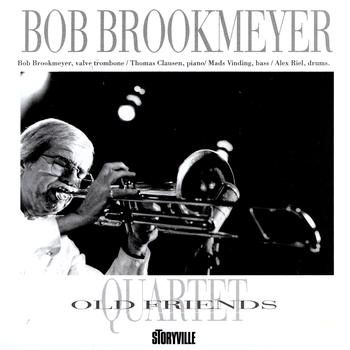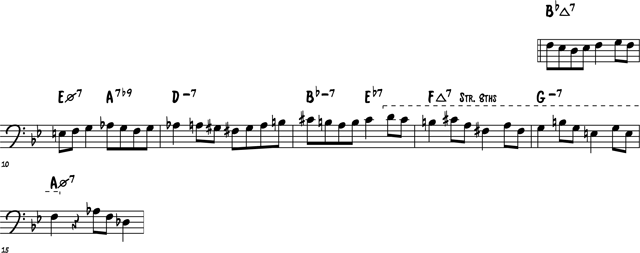 In my second year at New England Conservatory, I had the honor of studying with Bob Brookmeyer, the wonderful composer, pianist and trombonist. Much of our time was spent talking about thematic development and finding ways to play more freely within the changes. Bob had me try all sorts of experimental ideas, including two particularly useful/unusual techniques:
In my second year at New England Conservatory, I had the honor of studying with Bob Brookmeyer, the wonderful composer, pianist and trombonist. Much of our time was spent talking about thematic development and finding ways to play more freely within the changes. Bob had me try all sorts of experimental ideas, including two particularly useful/unusual techniques:
- Playing simple ideas and transposing them logically to each other, with no real concern for changes I was playing over…in other words…let the idea, not the chords, be the guide. I call this chromatic sequencing.
- Using free atonality over changes. In early stages, he had me playing 12-tone-rows over conventional standards. That was some intense ear work there…
And he suggested I check out his performance of “Stella By Starlight” from his live recording Old Friends to hear these at work. At the time, I just picked a few choruses…wild stuff. He plays alone at first, and then with bass, so loosely around the chords that my analytical mind was spewing smoke trying to “get it”. It clicked when I stopped trying to justify the notes harmonically, and just listened to the development of the ideas.
Recently, inspired by Hal Crook’s How to Improvise, I’ve been obsessively working on motivic development. It made me flash back to this solo, which I’ve now completely transcribed…all friggin’ 12 minutes of crunchy notes, endless development, and immaculate groove.
So Bob, with great thanks and respect for your teaching, this one’s for you.
- Bob Brookmeyer plays “Stella By Starlight” (Bass Clef)
- Bob Brookmeyer plays “Stella By Starlight” (Bb)
A bit of analysis
As many of you are probably aware, Bob Brookmeyer composes with a very modern harmonic vocabulary. Compositions such as “ABC Blues” & “Hello and Goodbye” demonstrate advanced scales, modern chord structures built from clusters and a liberal use of dissonance.
It should come as no surprise that his improvisations show this as well. There’s a frequent use of symmetrical scales and melodic minor modes, as well as “note sets” that don’t come from any obvious tonal category. Here’s a few choice moments:
- G7 in Bar 4 – a clear use of Whole Tone
- D-7 in Bar 20 – Whole Tone also, but a more dissonant version with a Major 3rd
- G7 in Bar 126 – Half-Whole Diminished
- The Bridge of Chorus D – a group of sequenced Whole Tone phrases
And of course, lots of other less obvious hints of these scales run throughout.
More importantly though, I feel Bob wasn’t concentrating on these specific sonorities. The performance sounds and plays more like he is painting with intervals. I get the impression of splashes of color, rather than any attempt at flagrant dissonances. The effect comes off as more controlled and sophisticated than a player just striving to “play out”. And the solo is performed with a playful atmosphere and a free-flowing quality that keeps some pretty hairy clashes from sounding grotesque.
So how do you take advantage of these ideas? You’ll need to get comfortable with a richer palette of colors. #5’s and #9’s on Major chords, the occasional Major 3rd on a Minor chord…that sort of thing. Here’s an ear training exercise (not for the faint of heart or the squeamish traditionalist) to improve dealing with these sounds:
- Compose a 12-tone row…really easy…just write all 12 chromatic notes without repeating any. But don’t write randomly. Try to make the order sound good.
- Now play a “C” drone…on the piano or whatever.
- Here’s the tricky part…sing your line, one note at a time against the drone. Check on the piano once you’ve found it. Are you on the right note? Is it in tune?
- Change the bass (maybe up a 1/2 step) and its like having a whole new phrase.
- Once you sing the lines consistently, change from a 1-note drone to a complete chord. CMaj7 or E-7b5…etc. Now you’ll get to hear some of those really unusual clashes…a natural 5 on a b5 chord or a Major 7th on a dominant chord.
Be patient…it took a while to get good at this. But there were a lot of great side-effects. Chord sounds became sharper in my mind, I got comfortable recognizing and playing exotic sounds over changes, and I started hearing melodies with surprising notes.
A few choice moments
Starting in measure 9, Bob begins the first of many extended lines that sequence using their own logic, rather than the prevailing harmony. Check out how the rhythm and shape keeps the line working…even when he’s WAY outside (F# minor over D-7 anyone?):
Several times, Bob splits from “running changes” not for the sake of dissonance, but to play more bluesy. Check out this Bb Blues Scale drenched bridge starting in measure 49:
The A section beginning at 97, and all of letter J are great for this too.
One more…a great Melodic Minor inspired moment from measure 155. The tip-off that this comes from Melodic Minor is the use of Natural 9s on the half-diminished chords and the #9 and #5 on the F7b9. This is my favorite lick from the whole thing.
Alright…good luck with all that. Happy shedding!





Great job Adam! I have been working on Hal Crook’s book too and ironically trying hard to get my head out of the changes and play lines that I hear even if they don’t “fit”. Thanks for this – I can’t wait to explore it more. 🙂
Thanks for the insights and feedback. This one was a real pleasure to transcribe…so many layers and great moments to be found.
I’m seeking clarification on what you mean by composing a 12-tone row. Do you mean a phrase that contains all 12 tones, with no repeated tones?
i.e. D, Db,C, F, E, Eb, Ab, G F#, B, Bb, A
Then to try singing such a phrase over various pedal points?
That’s right…but I think you’ll find the row you wrote too “easy” because of all the consecutive chromatics.
Here’s a Schoenberg row (op. 33a) – Bb F C B A F# C# D# G Ab D E
That’ll give you a bit more variety. Start by singing over C (or any pedal point). When you get good at it, try singing over any other tone. Then its onto chords…much more challenging because of the “wrong notes”.